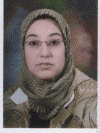Day :
- Track 3: Recent Developments
Track 4: Veterinary Medicine
Track 8: Livestock Management and Companion Animal Behavior
Track 9: Poultry Production
Session Introduction
Flaviana Santos Wanderley
Universidade Estadual de Ciências da Saúde de Alagoas
Brazil
Title: Venereal transmission of Toxoplasma gondii in goats after a buck was experimentally infected
Time : 10:00-10:25

Biography:
Flaviana Santos Wanderley has graduated in Veterinary Medicine from the Federal University of Campina Grande, specialization from the Federal University of Minas Gerais, Masters in Development and Environment, Federal University of Alagoas and a PhD in Animal Bioscience the Federal Rural University of Pernambuco. He is currently Medical and Veterinary Professor at the State University of Health Sciences of Alagoas (UNCISAL). He has experience in the area of Parasitology with emphasis on protozoosis.
Abstract:
The aim of the present study was to assess the venereal transmission of Toxoplasma gondii in goats. Two bucks of reproductive age were used. One of them was infected orally with oocysts of T. gondii, whereas the other buck was not infected (control). Ten does were randomly allocated into two groups (G1 and G2), each with five animals. The does in G1 were mated with the buck that had been experimentally infected with T. gondii oocysts. Those in G2 (control) were mated with the serologically negative buck. Infection of the buck and does from G1 was confirmed based on clinical, serological, molecular and histopathological findings. The buck in G2 and all of the females that mated with him were negative in all tests. With regard to gestational development among the females in G1, the following results were recorded: Embryonic re-absorption occurred in one animal on day 34 after mating; one animal aborted on day 42 after mating; the three other females gave birth to full-term healthy kids. One of these kids exhibited PCR-positive blood at birth. In total, 40% of the does in G1 and 80% of the kids born alive in G1 were PCR-positive in at least one organ. The present study demonstrated that venereal transmission of T. gondii occurs in goats with vertical transmission occurring from does mated with an infected buck to their kids.
Ashraf M Ahmed
King Saud University
Saudi Arabia
Title: Bacillus thuringiensis strains native to Saudi Arabia with enhanced larvicidal toxicity against the rift valley fever mosquito vector Aedes caspius
Time : 10:25-10:50

Biography:
Ashraf M Ahmed has completed his PhD from Keele University, UK, on 2002 and has ongoing Research Fellowship at Keele from 2004 until now, and Fellow of the Roial Society, UK, in 2004. He is a Professor of Medical Entomology at Zoology Department at El-Minia University, Egypt, (currently at King Saud University, Saudi Arabia). His current research interest is “mosquito immunity and biocontrol”, aiming at utilizing the immune response of mosquito vectors against mosquito-borne disease agents, and biological agents in the biocontrol measures against mosquito vectors. He has successfully achieved several grants for research projects, and got two currently ongoing granted projected (1.6 million Saudi Riyals each). One grant is for isolating native mosquito <i>Bacillus thuringiensis</i> bacteria with enhanced larvicidal activities for use in the battle against mosquito vectors in Saudi Arabia. The other grant is for isolating immune peptides from honey-bees for use as natural antibiotic against the American Foal Broad disease (AFB) that threatens the global Apiary industry. He had successfully monitored undergraduate, postgraduate students and research scholars. His academic output consists of more than 26 papers in reputed journals, membership of several Scientific societies, attended several local, national & international conferences and invited for main talks in many international conferences.
Abstract:
The bacterium Bacillus thuringiensis is a safe eco-friend entomopathogenic bio-control agent widely used to complement chemical control. Hence there is an urgent need for characterizing novel isolates with potent larvicidal activity against mosquito vectors. The present study was initiated to characterize new native Bacillus thuringiensis isolates with mosquitocidal activity from various samples from 16 regions across the Saudi Arabia. Various samples were collected from mosquito breeding sites across different regions in the country and screened for Bacillus thuringiensis isolation. Bacillus thuringiensis isolates were characterized on the basis of colony morphology; shape of spores and parasporal crystals and through comparisons of biochemical profiles. The larvicidal activity (LC50 and LC95) of standardized spore/crystal mixtures of Bacillus thuringiensis isolates were tested against larvae of the Rift Valley Fever (RVF) mosquito vector in Saudi Arabia, Aedes caspius at 24 hours post-treatment and compared with that of the Bacillus thuringiensis israelensis (Bti-H14). A total of 23 (out of 68 native Bacillus thuringiensis isolates) were mosquitocidal. Larvicidal strains were similar in terms of colony morphology, hemolytic and motile. Out of the 23 isolates, 9 showed significantly higher activity (LC50 range from 3.90 to 9.5 µg/ml) than the Bti-H14 (LC50 of 13.33 µg/ml) with one strain having as much as 3.4-fold higher activity than the Bti-H14. This is the first report of Bacillus thuringiensis strains native to Saudi Arabia with significantly enhanced larvicidal efficacy against the RVF mosquito Aedes caspius. These novel Bacillus thuringiensis strains may therefore contribute to novel potent biopesticides and help mitigate the risk of Bacillus thuringiensis resistance emergence in bio-control programs targeting RVF vector populations.
Barbara Bażanów
Wrocław University of Environmental and Life Sciences
Poland
Title: Exotic vector-borne viral zoonoses - A threat for diseases-free countries?
Time : 10:50-11:15

Biography:
Barbara Bazanow has completed her PhD at the age of 30 years from WrocÅ‚aw University of Environmental and Life Sciences. Since 2004 she works as an adjunct. Her main responsibilities are the virological and serological diagnosis of the domestic and wild animal diseases, the investigations of virucidal activity and cytotoxicity of new synthesized chemical compounds and plant extracts. She is a member of PTNW (Polish Society of Veterinary Sciences) and Polish Pharmacopoeia. She was apprenticed in Johannesburg (NICD) and Pretoria (Onderstepoort Veterinary Institute) –South Africa. She has published many papers in reputed journals.
Abstract:
In the case of many zoonotic viruses generally regarded as exotic, change in climate, travelling, migration of people and animals are some factors endangering disease-free areas. Serological monitoring of animals is a corner stone in outbreak prevention. These investigations afford to early detection of virus and assess scope of the problem. In our research West Nile virus (WNV), Crimean–Congo hemorrhagic fever virus (CCHFV) and Rift Valley fever virus (RVFV) were taken into consideration. Around five hundred cattle, five hundred horses and several dozen wild birds were serological investigated. Negative test results for CCHFV and RVFV were obtained. Surprisingly, a high percent of the collected sera tested positive for WNV. In recent studies antibodies against WNV were detected only in one horse. It clearly indicates spread of infection and pose a real threat of disease outbreak within human and animal population.

Biography:
Gabriela Lopez-Navarro DVM, MSc is in the final process to obtain the PhD at the National University of Mexico with the previous described study. She had been working as an Associate Professor at the Equine Medicine and Surgery Department of the Faculty of Veterinary Medicine for 11 years. Research interests are focused in equine lameness; diagnosis and treatments, and diagnostic imaging ultrasound in musculoskeletal problems, as a result of many years of involvement in the clinical practice of equine sports medicine and surgery.
Abstract:
Introduction
The aim of this study was to determine if the DBLPaN has lesions that suggest compression neuropathy as a source of pain in horses that have PSD. Histologic features of the DBLPaN of the lame thoracic limb of horses with collagen-induced PSD were compared with those controls.
Objective
To compare histological features in the DBLPaN of horses with induced PSD of a thoracic limb with histological features of this nerve in the contralateral control limb.
Methods
Adult mixed breed horses (n=8) with no evidence of PSD. Desmitis was induced in a thoracic limb by ultrasound-guided injection of collagenase. Eight weeks later a 2 cm portion of the DBLPaN was removed from each thoracic limb. Results. DBPaLNs of horses with collagen-induced desmitis had evidence of degenerative nerve compression such as: proliferation of endoneural myxomatous matrix, Renault bodies and myelin degeneration.
Discussion
Persistence of thoracic limb lameness in horses with PSD may be caused by compression of the DBPaLN, which innervates the proximal aspect of the suspensory ligament and may be the cause of pain causing lameness rather than pain originating within the proximal aspect of the suspensory ligament.
Conclusions
Chronic lameness in horses affected with PSD can be caused by compression neuropathy. The protocol was approved by the FMVZ-UNAM Institutional Animal Care and Use Committee.
James E Collins
University of Minnesota
USA
Title: Telepathology: A new frontier for global animal diagnostics training and service
Time : 11:55-12:20

Biography:
James E Collins is the Director of the University of Minnesota Veterinary Diagnostic Laboratory and a Professor of Anatomic Pathology in the Veterinary Population Medicine Department in the College of Veterinary Medicine. He has published more than 100 papers in reputed journals and has been serving as an Editorial Board Member of repute.
Abstract:
Tele-pathology, the practice of pathology at a distance, offers unique collaboration opportunities in pathology training, research and diagnostic and educational capacity building. Connecting pathology expertise and resources in one country or institution with other regions where critical knowledge and resource gaps may exist, highlights a remarkable area of improvement in targeting pathology training to the unique needs of partner institutions. In addition, this unique technology may help with the control and elimination of endemic trans-boundary animal diseases. Recent advances in web-based tele-pathology systems now enable dynamic real-time collaboration and consultation between individuals and institutions around the world. With the support of IVCC and Zoetis the University of Minnesota, College of Veterinary Medicine and the Minnesota Veterinary Diagnostic Laboratory has partnered with Jilin University in China and Yangling Besun Agricultural Industrial Group (Besun) pork production company to pilot a real-time, dynamic, web-based tele-pathology system, providing new opportunities to connect pathology training and collaborative efforts across two continents and three institutions.
Sameer Sawant
IDD Juvelit Group
Sweden
Title: One step ahead – To prevent mastitis in dairy animals
Time : 12:20-12:45

Biography:
Sameer Sawant has a Master’s of Veterinary Science degree and NET in Livestock Production & Management from ASRB. He is Vice-President in IDD Juvelit Group. He has completed Post-graduate in Marketing Management. He has Delivered Radio talks on “Veterinary & Animal Management” and has published more than 25 popular and research articles. He is Life member of various renowned Veterinary Associations and Management Institutes and Advisor to Vision 2020. He completed Management Development Courses: IMD, Switzerland; INSEAD, SIM, Singapore; IIM, Ahmadabad, India, was a Past Managing Board member/member and a Treasurer in Industry associations (CLFMA), (INFAH), CII, FICCI and a speaker in Industry Association Forum.
Abstract:
Bovine mastitis is very common in cows of both developed and developing countries. The prevalence of clinical and subclinical mastitis (SCM) varies from country to country. Various studies have been carried out to determine the prevalence of mastitis using various diagnostic tests by considering different risk factors like management practices, age, lactation, breed, season, quarters, and herd. It is observed that the older age and cows with later part of lactation period were more prone to bovine mastitis, and exotic breeds like Holstein freshen (HF) were more susceptible tobovine mastitis. Clinical and sub-clinical mastitis causes the most losses for milk producers the world over, despitethe knowledge possessed by veterinary medicine and researchers. Mastitis is the single biggest cause of slaughter amongst dairy cows in the world. Milk producers can handsomely profit from addressing the long-term health of their livestock udders. Many factors affect this health status, ranging from feed and water to the cow’s immediate environment; bedding material, hay quality, general barn hygiene, milking procedures etc. There are no short cuts when it comes to udder health. It requires targeted initiatives and determination by both livestock supervisor and owners to achieve long lasting change. There are countless success stories when udder health is actively addressed on a daily basis. The prevalence of subclinical and clinical mastitis was more in single and two quarters, respectively, and the rate of bovine mastitis was more in unorganized herds. It reflects that SCM is directly associated with management practices, age, lactation period, and environmental factors of the cow and clinical mastitis is more associated with breed, management and environmental conditions.
Mariano Hernandez Gil
National Autonomous University of Mexico
Mexico
Title: Equine welfare in practice: A handy method to spot behavioural, physical and clinical aspects threatening equid-human relationships
Time : 12:45-13:10

Biography:
Mariano Hernández Gil obtained a degree in Veterinary Medicine and Animal Science (MVZ) from the National Autonomous University of Mexico. Thereafter, he moved to the Autonomous University of Yucatan to obtain a Master’s degree (MC) in Animal Nutrition. After that, he joined The Donkey Sanctuary - World Horse Welfare - UNAM joint program to improve the quality of life of working equids in Mexico, collaborating to identify factors putting welfare of equids at risk and addressing root causes. He is currently the head of the Equine Department at the College of Veterinary Medicine and Animal Science of UNAM and the Country Manager of The Donkey Sanctuary - UNAM Program. Involved in education, extension and practice he promoted the benefits of proceeding with welfare in mind, always standing up by what a professional must listen from people in “equid-humanship” while incorporating developments in science.
Abstract:
Equids make a valuable contribution to humanity by satisfying social, cultural, physical, emotional, mental or economic needs. However, their performance depends greatly on their welfare. Whilst it is recognised that the welfare of the animal is a key factor in the management of a patient, veterinarians often do not take the time to assess and discuss the animal’s welfare with the owners. Early detection of a welfare problem, either by the vet or the owner, allows a quicker intervention and a better outcome for the animal and, in due course, for the humans relying on them. The aim of this presentation is to share experiences of the donkey sanctuary – UNAM Program on how we assess equine welfare in practice, using a simple but structured tool based on the hand to remind the assessor which behavioural, physical and clinical aspects to look for. The palm of the hand represents the life of the equine, its husbandry and its working practices, and the five fingers represent the main welfare indicators: 1) Human-equid interaction; 2) nutritional state; 3) wounds; 4) lameness; and 5) disease. The Hand reminds us to look at our equines in a holistic way, recognising that their welfare is a product of how they are used and the relationships between the owners and their animals. Through the five welfare indicators, we can rapidly assess the primary welfare problems. This approach allows us to prioritise where and how we work, targeting our resources to alleviate specific welfare problems of the equines in our program.

Biography:
Ahmed Hassan has completed his PhD at the age of 31 years, faculty member in Cairo University, former Fulbright postdoctoral researcher, Iowa state university, Animal science department. He has worked for King Faisal University (KFU) since 2008. He is the scientific supervisor of poultry research unit, KFU. He has special interest in local chicken breed conservation and the relationship between genetic makeup and immune performance of chicken under harsh environments. He has published more than 15 papers in reputed journals,9 funded research projects and has been serving as a scientific reviewer for the Fulbright commission Cairo regional office.
Abstract:
Forty-five Hisex commercial layers and forty-five local Saudi breed layers were used to compare and assess the effect of water restriction under hot conditions on blood constituents and immune response to Newcastle disease (ND) vaccine. The trial was divided into three periods: control (7 day), water restriction (14 day) and rehydration (7 day). During water restriction, layers from each breed was divided into three groups that received 0%, 20% and 40% restriction of drinking water relative to the control period. The immune response against ND was affected by breed; it also declined significantly with 40% water restriction 10 dayspost-restriction. Water restriction did not affect hematocrit value, plasma total protein, albumin, glucose or osmolality, which may not suggest a reduction in plasma volume. However, plasma creatinine increased in both breeds because of water restriction that remained elevated during rehydration. Water restriction increased plasma urea in the local group, while it decreased in the commercial group. Irrespective of rate of water restriction, it can be concluded that the two breeds can withstand up to 40% water restriction during high environmental temperature. However, the local breed may be superior in water conservation in relation to the commercial layers.
Fernanda Carlini Cunha dos Santos
Universidade Federal de Pelotas (UFPel)
Brazil
Title: Hematoma in the spermatic cord in association with orchitis in a stallion

Biography:
Fernanda graduated in Veterinary Medicine at Universidade Federal de Santa Maria (UFSM), Rio Grande do Sul (RS), Brazil. She completed the internship at Universidade Federal de Pelotas (UFPel), RS, Brasil and the Master’s degree at UFPel, with emphasis in Equine Reproduction. Nowadays works at UFPel as temporary professor (animal reproduction and obstetrics) and researcher in Equine Reproduction field.
Abstract:
Reproductive tract injuries may result in impotentiacoeundiand generandi, therefore requiring periodic evaluation. This study aimed to report a case of hematoma in pampiniform plexus and orchitis in a stallion.An equine, male,Crioulobreed, 6 years-old, was attended during reproductive season due to an increase in scrotal volume. During clinical evaluation all vital parameters were within reference limits and it was observed enlarged, edema, heat and pain in the scrotum and testicules bilaterally. In the dorsal board of right testicle, in the spermatic cord, there was a structure firm to palpation and anecoicat ultrasound exam. In Eco Doppler exam it was observed anechoic liquid in vaginal tunic, compatible with transudate, and an anechoic structure with irregular edges, avascularized, 2.7cm width and 1.3 cm height.The diagnosis was hematoma in the spermatic in association with orchids. Initial treatment was based on flunixinmeglumine 1.1 mg/kg IV, dexametasone 0.01mg/kg IV for 3 days and cold bath for 20 minutes. After 7 days, inflammatory local signs have declined. After 15 days, the stallion showed again scrotaledema and was treated with pentoxifylline6 mg/kg PO for 30 days, dexamethasone 0.05 mg/kg IV for 3 days and cold bath. After 83 days,there was no inflammatory signs in the reproductive tract and testicular parenchyma had homogeneous echogenicity.The diagnosis was based on clinical, hematologic, seminal and ultrasonography evaluation, which confirmed the presence of a hematoma in the pampiniform plexus and testicular inflammation. The stallion was regularly assessed and responded to therapy approach, with a favorable prognosis.
Vlatko Ilieski
Animal Welfare Center
Macedonia
Title: Usage of tri-axial acceleration of the hind leg for recognizing sheep behavior

Biography:
Vlatko Ilieski worked as a Doctor of Veterinary Medicine; Veterinary faculty Zagreb, Croatia (1991). He completed his MSc studies on “Coronary Circulations at different Brides of Swine†at the Institute of Functional morphology Medicine faculty-Skopje in the year 1996. He obtained his PhD working on the topic: Morphological characterizations on coronary arteries in relations of myocardium in swine heart at Faculty of veterinary medicine, Skopje (1999). Then after completion of his PhD he became a full Professor in Anatomy for Animals, Faculty of Veterinary Medicine Skopje, Ss Cyril and Methodius University, Appointed Professor For Animal Welfare and currently teaching in Anatomy of domestic animals, Animal welfare, Protection of animals used for research and education. His research focuses on field of Functional morphology, Animal welfare and 3R concepts.
Abstract:
Measuring the leg position and its motion could indicate strong distinction between sheep’s lying, standing and gait types which could define sheep behavior and their welfare state. Tri-axial accelerometer simultaneously records acceleration and inclination through measurement of an analogue signal in each of its three axes (X, Y and Z) converting it to gravity units on different time logging interval. The objective of this study was to analyze the position and locomotion of the sheep’s hind leg using attached accelerometer and to interpret the gathered data. Six sheep (3 rams and 3 ewes) divided in two groups (gender division) were used in this experiment. HOBO Pendant G tri-axial acceleration data logger was attached on the lateral side of the metatarsal region on the left hind leg. For the standing position the acceleration of the x-axis was in range 0.8 and 1 g (x̅=0.937±0.035) and the sum vector was from 0.85-1.3 g (x̅=0.988±0.006) with the time interval longer than 0.7 seconds. The single step analysis of walking and running showed distinctive patterns of the x-axis acceleration during stance and swing phase. The frequencies of acceleration values of x-axis and sum vector showed significant differences in the category 0-1 g for walking. Defining thresholds based on the frequencies of acceleration values are the most reliable approach for acceleration analysis. The defined thresholds for sheep can be used for behavioral research and sheep locomotion as well as a tool for herd and sheep behavior and animal welfare assessment
Khaja Mohteshamuddin
Karnataka Veterinary, Animal and Fisheries Sciences University
India
Title: Therapeutics of immunomodulatory approach for treatment of infertility in bovines

Biography:
Khaja Mohteshamuddin is currently working at Karnataka Veterinary, Animal and Fisheries Sciences University, India.
Abstract:
Infertility in bovines had been a major cause of concern for the dairy/beef farmer. In order to produce a calf per year, the reproductive management has to be in synchrony with the common managerial practices in the farm and hence requires the latest reproductive management tools to aid such thing. With increased inflation in the food commodities and particularly in prices of FMCG, every liter of milk owe lot of economic value to the farmer, hence optimum reproduction followed by production is the need of the hour in developing countries. Hence reproductive management with advanced reproductive tools has gained lot of importance in the recent past. Infertility is the major reproductive threat posing severe economic losses to the farmers’ livelihood. One of the major causes of infertility is sub-clinical, retrograde uterine infections. Several antibiotics have been tried by different scientists with varying results. Recent approach warrants the use of immunomodulator therapy, clearing infection, increasing uterine tone, avoiding antibiotic resistance and residues, and hence acting as the most effective and economic approach in augmenting fertility.
Tsegay Teklebrhan
Haramaya University
Ethiopia
Title: Assessment of commercial feedlot finishing practices at eastern Shoa, Ethiopia

Biography:
Tsegay Teklebrhan has completed his Rank of Assistant Professor at the age of 28 years from Haramaya University. Currently he is engaged in Teaching, Research and community service. He has published more than 7 articles in reputed journals.
Abstract:
This study was conducted to characterize and identify husbandry practice and major constraints of commercial feedlot industries in the study area. Forty eight commercial feedlot farms were used to collect data. Data were analyzed using Statistical Package for the Social Sciences (SPSS). The results showed that, livestock species such as cattle, shoat and camels were used in commercial fattening though significant variation in demand among species. Cattle had got highest acceptance in feedlot industries followed by shoat however; camel and swine had least preference. All cattle breeds had equal requirement by domestic market. However, there is variation in demand among cattle breeds for export market. Boran was the most preferred cattle breed compared to the rest of cattle by the importers. Uncast rated bull demanded for export market however, castrated and female cattle were not used for export markets. Pastoralists were the potential supplier of feeder livestock followed by small holders to feedlot industries. Teff straw was predominantly used roughage feed in most of commercial feedlot farms and agro-industrial by products as a source of concentrate. However, sorghum and maize grains were utilized by very few farms. Vitamin and mineral supplementation were not often available except, common salt in all feedlot rations. Market was noted as the most potential constraints followed by feed and type of livestock coming to the markets in the commercial feedlot industries. The study suggested that, government and other development partners should provided and improve all services to pastoralists or producers in an organized way at their locality that would ensure sustainable supply of livestock to the market.
Olufunmilayo A. Adebambo
Federal University of Agriculture
Nigeria
Title: Molecular characterization for genetic improvement of the indigenous chicken types in Nigeria

Biography:
Olufunmilayo Adebambo completed her PhD in Animal Breeding and Genetics at the University of Ibadan, Nigeria in 1976 at the age of 28 years. She became a Professor in 1996 at the Federal University of Agriculture, Abeokuta. She was the first Head of Department of Animal Breeding and Genetics from 1993 to 2000, the Dean of the College of Animal Science and Livestock Production from 2000 to 2006, member of the University’s Governing Council from 2001 to 2005, foundation Council member of the Nigerian Institute of Animal Science, the regulatory body for all Animal Husbandry Practices in Nigeria from 2007 to 2010 and the Project Leader for Indigenous Poultry breeds development for Nigeria funded by the Bill and Melinda Gates Foundation. She has more than 140 publications in reputed journals and refereed conference proceedings.
Abstract:
The Indigenous chicken strains of Nigeria are of small body size, laying few and small sized eggs but are relatively rugged, adapted and tolerant of several endemic local diseases yet surviving as scavengers.
Genetic characterization of the strains started in 1994, while molecular characterization started in 2004. Using 15 microsatellite markers, we studied the mean number of MS alleles per population in 3 populations from 3 regions of the country. A range of 5.27±0.51 alleles for NW to 6.20±0.66 for SW chickens, while effective number of allele contributing to the population ranged from 2.10±0.17 for NE to 2.82±0.24 for SW chickens with observed heterozygosity from 0.40±0.06 to 0.53±0.05 for NE and SW chickens.
To assess genetic diversity of the birds, blood samples were analysed from the four strains for protein resolution using SDS–PAGE. The dendrogram developed revealed that the strains were clearly separated from one another with mean genetic similarity of 55%, the naked neck strain being the most divergent. The diversity was further determined in relation to other African and Asian chicken genotypes in a collaborative study using mitochondrial DNA markers to quantify maternal evolutionary trend in relation to World Clade distribution. in a diverse gene pool using high density (600k) SNP array. Our findings showed observed heterozygosity ranging from 0.3±0.04 (Ethiopia) to 0.36±0.04 (Pakistan). SNPs, deviation from HWE (p≤0.05) was least in Kenyan chicken (0.96%) and highest was in Ethiopian chicken (1.57%). Principal component analysis (PCA) showed modest separation of the 6 populations. Using ï¬rst and second principal components (PC1 and PC2) 44.34% and 4.39% of the total variation could be explained, respectively, while admixture analysis and phylogenetic tree grouped the populations to 3 clusters.
To make the indigenous chicken commercially viable and sustainable, marker assisted selection based on genome wide and Epi-genome wide SNP markers will be pursued to speed up improvement program for various qualitative and quantitative traits.
Petros Admasu
Jigjiga University
Ethiopia
Title: In vivo antirabies activity evaluation of hydroethanolic extract of roots and leaves of Phytolacca dodecandra

Biography:
Petros Admasu is currently working at Jigjiga University, Ethiopia.
Abstract:
Rabies remains a major cause of death and severe economic impact in Ethiopia regardless of the availability of effective vaccines for its control. Where rabies vaccines are physical inaccessible and economically unaffordable, folk drugs is an option for rabies treatment in different areas of Ethiopia. Phytolacca dodecandra is used widely for traditional treatment of rabies. The study was undertaken to evaluate antirabies activity of hydroethanolic extract of roots and leaves of P.dodecandra by using mice model. All groups of mice challenged with rabies virus (CVS-11) containing 50-200MIMLD50 at day 0. Treatment groups of mice were orally administered with dose of 300, 600 and 1000 mg/kg of both parts of the plant extract dissolved with 1ml distilled water for seven consecutive days after an hour of CVS challenge. Control group of mice only administered with distilled water as placebo. Comparison of group of mice made based on the difference in survival rate and period (days). The result showed all doses of roots and, 300 and 600mg/kg doses of leaves of the plant extract didn’t significantly (P>0.05) increase the survival period of mice compared to the control group. However, 1000 mg/kg dose of leaves of the plant extract was significantly (P<0.05) increased the survival period of mice as compared to control group. Though the finding indicated the existence of some antirabies activity in extract of leaves of P.dodecandra at higher dose, the plant didn’t safe mice from deaths. Further research (elucidating its active principles) is needed before using the plant to treat rabies.
- Workshop on: Improving the health status of the animal to enhance the quality of milk
Session Introduction
Francesco Napolitano
Animal Production Research Centre
Italy
Title: Defining blood and milk biomarkers for healthy status
Time : 11:15-11:45

Biography:
Francesco Napolitano has completed his PhD in Animal Production Sciences in July 1990, Faculty of Agriculture, University of Naples, Italy. As senior researcher at the Animal Production Research Centre (Council for Agricultural Research and Economics, CRA) he is scientific responsible of the project “Improvement of the Italian livestock through advanced tools of genomics, transcriptomics and proteomics – GENZOOT” (2006-2015). He published more than 20 papers in the last five years.
Abstract:
The progress in research on the immune-physiology, is witnessing a growing interest in the system of regulation of the immune response. One of the most critical moments, in terms of changes that occur in the immune system of dairy cattle, is the peripartum. For this physiological stage, it is generally spoken of a state of immunosuppression, which is important to assess the extent and duration. In addition, it is necessary to clarify in precise terms which parameters could define the condition of immunosuppression. In fact, for some parameters such as the leucocyte and neutrophils count in peripheral blood, it seems to be an increase in this phase; however, what seems altered in negative measure is the real ability of these cells to carry out their functions of defense. Diseases at calving and during early lactation account for the major health and welfare problems in dairy production. These include production diseases such as fatty liver, ketosis, rumen acidosis and lameness and infectious diseases such as mastitis and reproductive tract infections. Infertility and disease are strongly inter-linked through communal metabolic and immune signaling pathways. A number of biomarkers are well described in blood but are currently less well characterized in milk. Potential milk biomarkers are free glucose, iso-citrate, beta-hydroxy-butyrate (ketosis and fatty liver), lactate dehydrogenase (mastitis), progesterone (infertility and metritis). An increase in intrinsic resistance to disease will result in reduced antibiotic intervention. This will not only lead to an increased food-product quality, but may also help to slow down the development of multi-drug resistant bacteria.
Cinzia Marchitelli
Animal Production Research Centre
Italy
Title: OMICS technologies for analyzing diseases in livestock species
Time : 11:45-12:15

Biography:
Cinzia Marchitelli graduated in 1992 in Biological Sciences (Università degli Studi di Roma), and she has completed her PhD in 2000 in Biotechnology and Genetic improvement of domestic animals (Università degli Studi del Molise). From 2010 she is a researcher at CRA-PCM and her research interest is the application of molecular biology to animal production. She is a leader of research unit of EU project GplusE “Genotype plus Enviroment” and of an Italian project “REDBOV- “Increase of profitability by improvement of technical and biological parameters”. Author and co-author more 20 peer-reviewed papers.
Abstract:
For several decades, the advances that have been made in breeding goals have been based on the needs of breeders; however, they are also influenced by consumers and societal needs related to food safety and efficient and environmentally sound production. New functional traits are growing in importance because of recent declines in animal health and fitness. They have also become more important because of growing concern about animal well-being and consumers' demand for healthy and natural products. There are major concerns about the impact of drugs used in veterinary medicine on the spread of antibiotic-resistant strains of bacteria that can negatively impact human health. Technical progress in the field of next-generation sequencing, mass spectrometry and bioinformatics facilitates the study of highly complex biological processes. In general, integration of the main Omics-technologies genomics, transcriptomics and proteomics in live science promises highly detailed information about the specific research object and helps to understand molecular changes in response to internal and external environmental factors. Here we will provide a general overview about the recent Omics-based research to study diseases in livestock. These approaches aim to define the gene pathways and networks governing animal immune response, host-parasites interactions or to help to understand the complexity of reproduction to resolve some reproductive diseases.
- Special Session
Session Introduction
Glen E Aiken
USDA-ARS Forage Animal Production Research Unit
USA
Title: Risk of exposure of grazing animals to toxic alkaloids produced by fungal endophytes
Time : 11:50-13:00

Biography:
Glen E Aiken completed his PhD in Agronomy from the University of Florida in 1989. He completed postdoctoral studies at Auburn University and Texas A&M University, and has worked as a Research Animal Scientist/Agronomist for USDA-ARS since 1992. He has served as the Research Leader for the Forage Animal Production Unit in Lexington, KY since 2013. He is a Fellow in the American Society of Agronomy and the Crop Science Society of America and has 94 papers in reputable journals and 111 book chapters, popular press aricles, and book chapters.
Abstract:
There are Epichloe and Balansia species of fungal endophytes that can infect various forage grasses and grow in the intracellular spaces of the grasses. Endophytes seasonally produce large concentrations of ergopeptine alkaloids, which cause a toxicosis in grazing livestock. Certain endophytes also produce indole diterpenoids that cause the staggers condition in livestock. Ergovaline is typically the ergopeptine in highest concentration and also is the most toxic. Claviceps fungi can infect inflorescence of cereal grains and certain forage grass species, and produce ergopeptines, most notably ergotamine, that cause the toxicosis, but certain species can also produce tremorgen compounds (Claviceps paspali). Signs of the toxicosis include reduced conception rates, retention of rough hair coats, depressed prolactin concentrations, elevated core body temperatures, and reduced DM intakes and weight gains. Signs of consumption of tremorgen compounds is excitability, persistent shaking, and incoordination. Animals are sensitive to these toxic alkaloids, with morbidities often above 80%; however, mortality is typically below 5 percent. The cost in animal production can be quite high, but management approaches can be taken to mitigate the adverse effects on animal physiology and well-being. There will be a discussion on the altered physiology of grazing animals inflicted with either the toxicosis or staggers and management approaches to mitigate or alleviate the toxicosis.
- Symposium
Session Introduction
Omar El Tookhy
Cairo University
Egypt
Title: Constructing schematic eye requirements steps and the obtained clinical values: A camel-eye model
Time : 12:15-13:00

Biography:
Omar El Tookhy has travelled for predoctoral scholarship and visits to Germany and Switzerland, postdoctoral study and work in Canada and has spent 3 years at Qassim University, KSA as vet-surgery professor. Currently he is working as a full professor at Cairo University, school of veterinary medicine, Egypt. He has published more than 21 papers in reputed journals and serving as a reviewer for some international journals in his field.
Abstract:
Eye is a homocentric system of lenses, which when combined in action form a very strong system of short focal length. A schematic eye is a self-consistent mathematical model of the optical system that simulate the real world performance of the eye and can be used for a range of research and development purposes. In schematic eyes model the compound optics of real eyes can be specified in terms of three cardinal points, making it possible to model paraxial ray paths and describe various optical characteristics of living eyes. Efforts to design an optical model of an eye dates back to Newton’s diagram of the sheep’s eye around 1680s. Schematic eyes have been designed for human, cow, horse, sheep, pig, dog, rabbit and rat. Several models have appeared over the last century, with different levels of complexity ranging from those with reduced or single refracting surfaces, to others that allow refractive index variation within the lens and have conicoidal, rather than spherical, retinal surfaces. The dimensions of ocular tissues vary from infantile to adult animals. These changes are probably the necessary concomitant of the increase in size of the eye during growth. Therefore, to accurately build a schematic model of a specific animal species ecobiometric values are needed to properly describe its visual properties. This allows the calculations of intraocular lens dioptric power to be deployed in the eyes of animals before cataract surgery to achieve emmetropia.
- Workshop
Session Introduction
Fred Williams III
University of Missouri
USA
Title: Diagnostic approach to abortion in domestic species
Time : 13:50-14:40

Biography:
Fred Williams III completed his undergraduate education at Tuskegee University and continued in the veterinary school there at Tuskegee to become a member of the class of 2001. He started a residency at the University of Missouri in 2002 and continued following the completion of his residency as a faculty instructor. Currently, he is at the University of Missouri as an Associate Professor in Pathobiology with a primary focus on clinical education of professional students and diagnostic work for the Veterinary Medical Diagnostic Lab at the University of Missouri. He has special interests in pathogenesis and exotic animal diseases.
Abstract:
Abortion losses can be a major loss for domestic animal producers. In some cases, nearly a year of preparation and great expense may be lost in an abortion. There are a number of infectious, toxicologic, and non-infectious causes for termination of or unsuccessful reproductive outcome of gestation. We will explore some of the common infectious causes based on species and typical diagnostic approaches used to identify a specific etiology. With potential emphasis on the discussion of zoonotic potential of several pathogens. Typical necropsy procedures particular to the fetal necropsy will be discussed. Additionally, typical complications to the identification of a potential etiology for abortion/stillbirth will be discussed.
- Track 1: Veterinary Science
Track 2: Animal Nutrition and Diseases
Track 10: Animal Models and Testing

Chair
Glen E Aiken
USDA-ARS Forage Animal Production Research Unit, USA

Co-Chair
Michael D Flythe
United States Department of Agriculture, USA
Session Introduction
Swanand R Sathe
Iowa State University
USA
Title: Laparoscopic artificial insemination techniques in small ruminants

Biography:
Swanand R Sathe is a board certified Theriogenologist who finished his residency training at the University of Illinois at Urbana-Champaign (UIUC) in 2011. He is a graduate of the Bombay Veterinary College (India) and holds Master’s degrees in Veterinary Internal Medicine (India) and Reproductive Biology (UIUC). He is currently an Assisstant Professor and section Head of Theriogenology at the Iowa State University College of Veterinary Medicine. His main areas of interest include embryo transfer techniques in a variety of species including small ruminants, equine and cervids. He has authored several chapters in major textbooks on theriogenology and published several articles.
Abstract:
Artificial insemination is a tried and tested method of improving flock genetics and is routinely carried out in several species worldwide. Small ruminants (sheep and goats) too have been artificially inseminated for several decades with varying success rates due to the elements of seasonality and anatomic pecularities of their reproductive tract. One such pecularity that has prevented producers from achieving higher pregnancy rates with traditional AI techniques is the presence of cervical rings. This is especially true in sheep where passing a insemiation rod and pipette is nearly impossible without causing trauma. Laparoscopic artificial insemination technique offers a newer way of circumventing the traditional route of AI and has the advantage of direct visual depostion of semen inside the reproductive tract. This method has shown to be superior in achieving higher pregnancy rates and efficiently using semen by reducing the the total numbers of spermatozoa deposited. Sheep, goats and wild cervids can be synchronized using various protocols and be bred on timed AI during and outside the traditional breeding season using laparoscopic methods. This has led to producers achieving two crops of offspring per year or lambing /kidding duirng a particular time of the year to meet market demands. In this talk we will focus on the current methods of synchronization of estrus as well as laparoscopic AI techniques that are currently utilized in small ruminant reproduction.
Omar El-Tookhy
Cairo University
Egypt
Title: Clinical and ultrasonographic findings of some ocular conditions in sheep goats and camels
Time : 14:40-15:05

Biography:
Omar El-Tookhy has travelled for predoctoral scholarship and visits to Germany and Switzerland, postdoctoral study and work in Canada and has spent 3 years at Qassim University, KSA as vet-surgery professor. Currently he is working as a full professor at Cairo University, school of veterinary medicine, Egypt. He has published more than 21 papers in reputed journals and serving as a reviewer for some international journals in his field.
Abstract:
Ocular diseases in food-producing animals play a signiï¬cant role in economic losses. Individual ophthalmic examinations are not frequently performed as part of a herd health program but are very important to ensure the herd health. Sheep and goats are highly exposed to outbreaks of infectious keratoconjunctivitis and other conditions causing corneal opacity. Early cases (70%) showed varying ocular conditions of anterior uveitis (46%) with other manifestations on the corneal and in the anterior chamber. Ultrasonographically, the pupil appeared constricted with increased hyperechoic thickening of the ciliary body. In chronic cases, corneal pigmentation (10%) and cataract (20%) were seen. Among camels, trauma-related problems were the most common eye problems. This included keratitis with/without the involvement of iris and ciliary body in the form of iridocyclitis (31%) and penetrating corneal wounds (23%). Lesser observations involving cataract (16%) and glaucoma (2%) were recorded. Posterior segment affections constituted (27.5%) and included intraocular tumour (2%), retinal detachment (6%) and blindness (20%). Ocular ultrasonography enables the visualization of inner ocular structures especially when corneal opacity prevents visualization of retrobulbar region. From the owner’s perspective, ultrasound provides a more precise tool for investigating the eyes and is influential in making decisions regarding the treatment of their animals. From the practitioners’ point of view, detection of ocular abnormalities using ultrasound prior to any interference helps in planning the possible way(s) of management and treatment. It also provides a better prognosis of the expected outcomes.
T K Gahlot
Rajasthan University of Veterinary and Animal Sciences
India
Title: Important surgical disorders of dromedary camels and their management
Time : 15:05-15:30

Biography:
T K Gahlot has completed his PhD at the age of 34 years from Haryana Agricultural University. He is the Director of Clinic, Rajasthan University of Veterinary and Animal Sciences, Bikaner, India and Professor and Head of Department of Veterinary Surgery and Radiology, College of Veterinary and Animal Sciences, Bikaner. He is Editor in Chief of Journal of Camel Practice and Research since 1994. He has published more than 150 papers in reputed journals and edited five books on camelids. He is Principal Investigator of Centre for Disaster Management Technologies in Animals at Veterinary University, Bikaner.
Abstract:
Surgical affections of camels lead to production losses. An overview reveals that camel surgery has two distinct divisions i.e., soft tissue surgery and orthopedic surgery. Majority of soft tissue surgery involved gastrointestinal tract and urogenital system. Surgical affections do occur at skin and adnexa. The current concept of surgery of camels is based on its surgical anatomy and accordingly deep intraoral surgery is performed to resect the injured soft palate of camel. Creation of drainage openings and counter openings in cases of saddle gall abscesses or contusions and sheath hematomas or abscesses require good scalpel skills. Herniorrhaphies or hernioplasties and urethrotomy or urethrostomy also need special surgical skills keeping in view the surgical anatomy of these anatomical parts. Rumenotomy or surgical opening of compartment 1 is done to remove foreign bodies through a small flank region in a camel secured in sternal recumbency. Cosmetic surgery to repair the torn nostrils due to abnormal pulling of nose pegs with halters and salvage surgery in cases of gangrenous tail marks the surgery of camel which is different from other species. Orthopedic surgery is usually restricted to repair the mandibular and long bone fractures specially cannon bones. A wide range of techniques involving interdental wiring, transfixation, bone plating and intramedullary pinning are done with varying success. The urogenital system surgeries involve those for cystorrhexis, obstructive urolithiasis, phimosis, paraphimosis and prepucial paralysis.
Cleber J R Alho
Anhanguera-Uniderp University
Brazil
Title: Wildlife of the Pantanal wetland and the effects of zoonosis due to interactions with domestic animals and cattle rising

Biography:
Cleber J R Alho is a retired Professor-Ecology Department: University of BrasÃlia (1965-1990); he was a Senior Program Officer for Brazil-WWF-World Wildlife Fund (1990-1995) and presently a Professor of Environmental Sciences-Anhanguera-Uniderp University (2002-present). He obtained his PhD in Ecology from the University of North Carolina at Chapel Hill, USA, (1977), Masters Degree in Helminthology from Instituto Oswaldo Cruz, Brazil (1965) and Postdoctoral degree from Smithsonian Institution, Washington-DC (Natural History Museum, 1989). Scientific publications in international journals and books initially on Parasitology and later on Ecology: Conservation biology, wildlife management including biodiversity of the Pantanal. He is the Director of Funatura dedicated to conservation.
Abstract:
The Pantanal is a large continental wetland in the center of South America mainly in Brazil, an important freshwater ecosystem. Heterogeneous habitats support a diverse and abundant biodiversity. Environmental threats include deforestation due to cattle ranching and introduction of exotic species. Land use with environmental pressures on natural areas exhibit strong implications for the health and well-being. Human clusters in disorganized settlements are harmful to regional biota favoring the proliferation of disease vectors of malaria, yellow fever, dengue fever, arboviral infections, filariasis and schistosomiasis. Leishmaniasis is associated with people who invade natural areas. Wild rodents, marsupials and domestic dogs are reservoirs of pathogens. Environmental change with insect attacks is illustrated by the outbreak of stable-fly (Stomoxys calcitrans) that occurs in cattle farms close to sugar-related activities. Rabies is a zoonotic disease caused by viruses which involves the interaction of man and domestic animals such as dogs, cats, cattle and swine herds with hematophagous bats. Outbreak of tick fever is caused by Rickettsia transmitted by Amblyomma, ectoparasites of capybaras. Trypanosoma evansi causes an important horse disease affecting cattle ranching activities. Alien species include: African grass Brachiaria spp., feral hog Sus scrofa, golden mussel Limnoperna fortunei, the fish Cichla ocellaris. Added to the defense of the values of biodiversity for ecosystem services that benefit human well being and health and the proven value of this huge collection of genetic diversity of the Pantanal wetland that has provided relevant services to the production of veterinarian research are the ethical and aesthetic values of biodiversity.
Xia Dong
Shanghai Academy of Agricultural Sciences
China
Title: The effects of potassium diformate on the early stage of weaning piglets
Time : 15:30-15:55

Biography:
Xia Dong had completed her PhD at the age of 36 years from Nanjing Agricultural University, China. She was a teaching staff at Nanjing Agricultural University from 1992-2006. In 1997-1998, she attended one year training course at Larenstein International Agricultural College of Deventer, the Netherlands. She had twice working experience at the Department of Functional Genomics & Bioregulation at Institute of Farm Animal Genetics Mariensee, Germany. She is a Senior Researcher in Animal Environment & Welfare at the Institute of Animal Husbandry & Veterinary Sciences, Shanghai Academy of Agricultural Sciences.
Abstract:
In practical, the loose of weaning piglets such as diarrhea, growth retardation usually happen in the first two weeks after weaning. Potassium diformate (KDF), an acidifier works as a potential non-antibiotic growth promoter has been shown to improve the performance in piglets growing- finishing pigs and sows. But it is not yet known whether KDF influence the gastrointestinal bacterial flora in the first two weeks after weaning. Therefore, a total of 180 piglets weaned at 28 days of age were allocated randomly into two groups, with 6 replicates in each group and 15 piglets in each replicate. Piglets in the control group were fed the basal diet, whereas the KDF-treated group was fed basal diet supplemented with 10 g/kg KDF. After 2 weeks feeding, KDF improved the growth performance, the apparent digestibility of nutrients and decreased the diarrhea index and frequency. Furthermore, KDF increased the relative copies of Lactobacili in the digesta of stomach and ileum, but did not change the relative copies of Lactobbacili in the jujunum, caecum and rectum digesta. KDF did not change the relative counts of Enterobacteria in the stomach digesta but decreased it in the jujunum, caecum and rectum digesta. However, the Shannon index and band number of DGGE profiles did not show difference between the control and the KDF-treatment. Altogether, our data suggests that the influence of KDF-treatment on the relative counts of Enterobacteria and Lactobacili in the gastrointestinal gut may contribute to the improvement of growth performance and health in weaning piglets.
Mohammed El Amine Benarbia
Nor-Feed Sud
France
Title: Reducing protein and energy rates in diet while maintaining broiler zootechnical performances: Case study of Nor-Spice AB® supplemented diet
Time : 15:55-16:20

Biography:
Amine Benarbia is a Doctor of Veterinary Medicine. He has completed his PhD in 2012 from Angers’s University and Postdoctoral studies from Inserm, a well-known organism in the biotechnology and medical research. He is a R&D Manager at NOR-FEED SUD, a premier French society developing vegetal based feed additives.
Abstract:
Broiler productivity has been enhanced by the considerable genetic improvement achieved in the last decades. However, the expression of broiler genetic potential is conditioned to an optimal nutrition and usage of antibiotics as growth promoter; Providing a well-balanced diet in term of Digestible Amino Acid (DAA) and energy while reducing the feed cost and maintaining zootechnical performances is a real challenge. Furthermore broiler producer in order to meet sustainable agriculture standards have to go through optimizing the use of resources in feed formulation and reducing the antibiotic use. Nor-Spice AB® (NSAB) is a citrus concentrate containing a set of well characterized phytochemical compounds with a documented prebiotic like effect and control of pathogenic bacteria. Monogastrics fed with NSAB supplemented feed displayed better growth performances. This trial was conducted in the Bangkok Animal Research Center aimed to investigate the effect of NSAB supplementation in a “low-cost” diet (-5% DAA, -7% energy) and to answer the question whereas it’s possible to reduce DAA and energy and still achieve zootechnical performances by supplementing diet with NSAB. 288 male broilers were allocated to 4 diets: Optimal diet and low cost diet with or without 250 ppm NSAB Supplementation. Zootechnical parameters were measured daily. Animals fed with NSAB supplemented feed showed 1.1% higher feed intake, an improved FCR (-0.019) and livability (+5%). Effect of NSAB supplementation was more evident in the case of “low-cost” diet. Indeed, Animals fed “low-cost” diet supplemented with 250 ppm NSAB reached similar final body weight as animal fed optimal diet without supplementation. These results suggest that plant based feed additive can be a solution for a more sustainable broiler production by optimizing the use of resources in broiler feed formulation without losing zootechnical performances.
Eman Ezz El Sharkawy
Assiut University
Egypt
Title: Chronic exposure to hexaconazole fungicide induced neoplastic changes in hepatocytes in male rats

Biography:
Eman Ezz El-Sharkawy has completed her PhD at the age of 31 years from Assiut University, Egypt and postdoctoral studies from Assiut University, Veterinary school of Medicine. Recently, she is the professor of forensic medicine and toxicology, faculty of veterinary medicine, a premier in toxicological studies of many environmental pollutants in the surrounding environment. She has published several papers in reputed journals.
Abstract:
Long-term hepatotoxic effect of commercial Hexaconazole, one of triazole fungicides was studied on male albino rats. Two groups of rats exposed to 75 or 150 mg/kg bw, Hexaconazole orally using stomach tube respectively for 12 months. Absolute and relative liver weights were recorded. Total protein, albumin and globulin levels were determined. Serum gamma glutamyle transferase (γ-GT), alkaline phosphatase (ALP), aspartate transferase (AST) and bilirubin concentrations were also recorded. Histopathological lesions in livers of exposed rats were described. Liver sections were submitted to immunohistochemical staining using glutathion-S-transferase placental form (GST-P) tumor marker for detection of carcinogenicity. A pronounced toxic effect was observed on liver where absolute and relative liver weight was significantly increased. A significant reduction was in total protein and albumin. A significant increase in the enzyme activities and bilirubin concentrations in exposed groups was recorded. Liver histopathology exhibited various abnormalities as hepatocellular swelling, hyperplasia of bile duct and hepatocytes hypertrophy with increase in microcytic degeneration. The most interesting finding was the presence of preneoplastic nodules which appeared by light microscope and confirmed with immunohistochemistry assessment. These results suggested that hexaconazole fungicide has hepatotoxic effect and tumor promoting activity on liver tissue when administered for 12 months.
Abd El Aziz Mousa Nour
Alexandria University
Egypt
Title: Some factors affecting condition factor of lake whitefish Coregonus clupeaformis in lakes Michigan and Huron, USA

Biography:
Abd El Aziz Mousa Nour is Professor Emeritus of Animal and Fish Nutrition, Alexandria University, Egypt. He was the Head of the Department of Animal and Fish Production Alexandria University, Egypt. He did his Postdoctoral Fellowship from National Institute for Research, UK.
Abstract:
Lake Whitefish (Coregonus clupeaformis; LWF) constitutes one of the most commercially harvested fisheries in the Laurentian Great Lakes. As a benthivore, LWF plays an important role in the Great Lakes food webs due to its remarkable ability to transfer energy from lower to higher trophic levels. This study was aimed to investigate the effect of seasonal fluctuated infection parameters of LWF collected from four sites in northern lakes Huron (Cheboygan and De Tour Village) and Michigan (Big Bay de Noc and Naubinway) from fall 2003 through summer 2006. A total of 1284 spawning LWF specimens were examined in order to evaluate whether prevalence, abundance and intensity of infection affected the LWF condition factor (K) after accounting for the effect of lake, sampling site, year and season on LWF growth and condition by calculating the residuals from the Generalized estimating equations (GEEs) and then using simple linear regression to relate the residuals to K. The results revealed a positive relationship between K and GEE residuals for parasitic infection abundance (Slope=26.46, SE=9.42) and intensity (Slope=47.17, SE=24.04) suggesting that individuals with greater than average parasitic infection abundance and intensity had larger condition factors than individuals with lower than average abundance and intensity. The test for whether the model coefficient was different from zero was statistically significant for parasitic infection abundance (t=2.81, P=0.005) but was statistically insignificant, although only marginally so, for parasitic infection intensity (t=1.96, P=0.051). It is important to note, however, that the total amount of variability explained in the parasitic infection GEE residuals by K was low (R2<0.02) for both models.
De Bastiani Grasiela
Universidade Federal de Santa Maria
Brazil
Title: Association of ultrasound and anatomopathological findings of equine metacarpophalangeal lesions
Time : 16:35-17:00

Biography:
De Bastiani Grasiela has completed her M.Sc at the age of 29 years from Universidade Federal de Santa Maria and in the moment postdoctoral studies from Universidade Federal de Santa Maria. She is specialized diagnostic images of the horses and professor of anatomy. She was assistant of CIRALE-Hippolia, Goustranville (France)with reputed professor Denoix Jean Marie.
Abstract:
To determine the association between ultrasonographic and anatomopathological findings, an ultrasonographic examination was performed post mortem on the fetlock and associated structures of 37 equine forelimb specimens. All of these specimens exhibited images suggestive of lesions on the ultrasound examination. Subsequently, these limbs were dissected and underwent an anatomopathological study. Ultrasonographic changes in size, shape, architecture and echogenicity of ligaments, tendons, joint capsule, articular cartilage and bony surfaces of the metacarpophalangeal joint were associated with the anatomopathological findings.
Schafer Salvadori Andressa
Universidade Federal de Santa Maria
Brazil
Title: Immune response of lambs experimentally infected with Haemonchus contortus and parenterally treated with a combination of zinc and copper

Biography:
Schafer Salvadori Andressa has completed her MSc at the age of 30 years from Universidade Federal de Santa Maria and in the moment Postdoctoral studies from Universidade Federal de Santa Maria. She has specialized in clinical pathology with emphasis on parasitology and worked at the Federal University of Parana for two years as a Research Associate in the laboratory of parasitic diseases.
Abstract:
The present study evaluated the immune response of lambs (21) experimentally infected with Haemonchus contortus and treated with Zn and Cu. Lambs were divided into three groups: Control group, infected group-infection performed with 15,000 larvae of H. contortus/animal and group infected and treated subcutaneously with 1.5 mg/kg of Zn and 0.45 mg/kg of Cu on days 10 and 45 post-infection [PI]. Blood samples were drawn on days 0, 14, 28, 42, 56 and 70 PI in order to determine the serum concentrations of IL1, IL4 and IL6, INFγ, TNF-α and IgA, IgE, IgG and IgM. At the end of the experiment, animals were euthanatized and the parasite load was quantified. In addition, the concentrations of Zn and Cu in liver were assessed. Between days 14 and 42 there was a significant increase (P<0.001) of cytokine and immunoglobulin levels in IG and ITG when compared with the animals of CG. After day 56, the IG animals showed serum level of interleukins and immunoglobulins lower than ITG animals (P<0.001). Regarding the liver concentrations of Zn and Cu the infection showed to lead to a depletion of these minerals; therefore, the supplementation did not prevent this effect. The results of this study indicate that the administration of Zn and Cu was capable of enhancing the immune response in lambs experimentally infected with H. contortus. However, it did not reduce egg counts in the feces or the number of adult parasites in the abomasum.
Hakimullah Hakim
Tokyo university of Agriculture and Technology
Japan
Title: Evaluation of SAHW for its bactericidal efficacy on E.coli and Salmonella, present on the glass plates and rayon sheets via in vitro experiments
Time : 17:00-17:25

Biography:
Hakimullah Hakim is currently a PhD student at the united graduate school veterinary science, GIFU University, Japan.
Abstract:
Presence of bioaerosol in the poultry farms might play as a potential risk for the outbreaks of some infectious diseases. Here we evaluated slightly acidic hypochlorous water (SAHW) (Hi-Clo Soft Acidic Water: OSG corporation, Osaka, Japan), for its ability to inactivate bacteria. SAHW (containing 50, 100 ppm chlorine, pH 6), was mixed with Escherichia coli or Salmonella Infantis in a reaction-tube, and its activity was stopped by adding fetal bovine serum (FBS), after a short time of exposure. SAHW efficacy was also evaluated after spraying by nebulizer on the both mentioned bacteria inoculated on the Rayon sheets or glass plates, inside a plastic box. After some moment of exposure, samples removed and placed inside a stomacher bags containing 10% FBS in phosphate buffered saline to stop SAHW’s efficacy. The remained bacteria were titrated on DHL agar to calculate their colony forming units (CFU)/ml. In the reaction tube, SAHW (50 and 100 ppm) could inactivate both bacteria within 5 sec of contacts up to the undetectable level (≤ 2.6 log 10 CFU/ml), but in the spraying form only SAHW 100 ppm was able to reduce titer of both bacteria within 7 min spray and 5 min contact times on the Rayon sheets, and 5 min spray and 5 min contact times on the glass plates up to lower than the detectable level. Our finding confirms SAHW has ability to inactivate both bacteria which are normally present at farms and acts as a powerful disinfectant.
Khatima Ait Oudhia
High National Veterinary School
Algeria
Title: Epidemiological survey for Toxoplasma gondii, Chlamydia psittaci var. ovis, Coxiella burnetii, and Brucella spp., among sheep from north Algeria

Biography:
Khatima Ait Oudhia has completed her PhD from High National Veterinary School in Algiers, Algeria and Post-doctoral studies from University of Medicine of Montpellier, France. She has published more than 10 papers in reputed journals and has been serving as an Editorial Board Member of repute.
Abstract:
A serological survey was carried out in the northern part of Algeria (Algiers, Tizi-Ouzou, Boumerdes and Bouira), for the presence of antibodies against Toxoplasma gondii, Chlamydia psittaci var. ovis, Coxiella burnetii, and Brucella spp. Out of 585 samples tested by, highest overall prevalence (36.2%) was found for Brucella spp. The 28.6% and 12.59% of tested sheep were positive for T. gondii and C. psittaci var. ovis respectively. A total of 12.2% were found to be seropositive for C. burnetii. Levels of these infections were found in all four prefectures. The demonstration of circulation of some bacterial and parasitic zoonotic agents in sheep flocks in the northern prefectures of Algeria, based on serological analysis, advanced the knowledge on pathogens affecting domestic sheep in Algeria. Considering the zoonotic potential of these pathogens, further studies are needed.
Shrikant B Katole
Anand Agricultural University
India
Title: Effect of moderate work on intake and serum profile of minerals in semi-captive Asian elephants (Elephas maximus) fed sugarcane based diet

Biography:
Shrikant B Katole has completed his PhD (2011) in Animal Nutrition from Premier Veterinary Research Institute IVRI, Izatnagar. He has been awarded ICAR’s prestigious JRF for his Master degree. He has published more than 25 research papers in journals of national and international repute and presented more than 30 research papers in various conferences/symposia and has been serving as an Editorial Board Member of reputed journals. His area of interest includes wildlife research on large herbivores and zoo animals. Presently he has been engaged with Teaching, Research and Extension Activities of the Anand Agricultural University, India.
Abstract:
Research conducted earlier indicates that exercise influenced absorption and utilization of minerals in horses. As there are similarities between horses and elephant with regards to metabolism of minerals, it would be logical to assume that exercise will influence absorption and utilization of minerals in Asian elephant (Elephas maximus) as well. Two feeding trials were conducted to study the effect of moderate work on intake and serum profile of minerals in semi-captive Asian elephants. Six elephants were divided into two groups. Animals in group I performed no exercise while those in group II performed 4 hour of moderate work. During both the trials, all elephants were fed a basal diet comprising of wheat-roti, sugarcane and tree leaves. Intake of sugarcane was higher (P<0.01) in group I while forage intake was higher (P<0.01) in group II. Serum concentration of Fe and Zn was higher (P<0.05) in group II. Apparent absorption of Ca, P, Fe and Cu was higher (P<05) in group II. It was concluded that 4 hours of touristic work is beneficial for semi-captive Asian elephants.
Khaja Mohteshamuddin
Karnataka Veterinary University
India
Title: An alternative approach for anestrus management in bovines under field condition

Biography:
Khaja Mohteshamuddin has completed his BVSc & AH, MVSc (Animal reproduction gynecology & obstetrics) and MBA (Human Resource & Development). He has excellent academic track record and proven skills in the field of veterinary science and gynecology. Has published several articles and abstracts in variuos national and international forums. A constant learner, with desire to acquire and upgrade knowledge.
Abstract:
A study was conducted on 156 anoestrus bovines (102 buffaloes and 54 cows) irrespective of their age and stage of lactation. The cases were randomly divided into two equal groups of 78 animals, each comprising of 51 buffaloes and 27 cows. In group I, the animals were administered with estrus inducer and mineral mixture as part of treatment protocol and in group II; the animals were administered homeopathic medications. In both the groups the animals were observed for estrus signs and were artificially inseminated. The number of animals exhibiting early signs of estrus was more in group II. The animals in group II showed (62.80%) more pronounced signs of estrus than that in group I (41.02%). The conception rate was more in group II animals (53.06%) than conventional group I (34.37%). Both buffaloes and cows responded well to both the treatment schedules and no noticeable side effects were seen. The alternative approach to conventional anestrus therapy was found to be cost effective as well as result oriented even under field conditions hence can be adopted as a cheaper and effective option for treatment of infertility problems in bovines.

Biography:
A O Gaja has completed his PhD at the age of 31 years from Yamaguchi University and spent 10 months as researcher in Kagoshima University. In 2013 he awarded Fulbright followship for visiting scholar at University of Illinois. He has published more than 7 papers in international journals and has been serving as an editorial board member of some veterinary journals.
Abstract:
The objective of the present field study was to establish the beneficial effects of re-insemination of non-pregnant cows using ultrasonography 20 to 23 days after the artificial insemination. A total of 245 Japanese Black cows were artificially inseminated and early pregnancy diagnosis (EPD) was performed on 92 cows 20 days after insemination using ultrasonography. The remaining 153 cows were considered as negative controls in which routine rectal palpation was performed for pregnancy diagnosis 45-50 days post-insemination. EPD revealed that eleven of the 92 cows (12%) were infertile due to ovarian abnormalities and were thus excluded from the rest of the study. Forty eight (59%) of the remaining 81 cows were diagnosed as pregnant, while the other 33 (41%) were diagnosed as non-pregnant. Of these non-pregnant cows, 17 of them received a dose of an analogue of the gonadotropin-releasing hormone (GnRH analogue) and were then timed-inseminated, while the other 16 were observed for estrus signs and 13 of them (81%) were artificially inseminated. Rates of conception were 35% and 38% in the GnRH and the artificially inseminated groups respectively (P>0.05). Total pregnancy rate for the EPD group increased significantly (74%).

Biography:
Nagarajan Baskaran has completed his PhD on Ranging and Resource use by Asian elephants in southern India and has been working on this species in wild and captivity in various parts of India since 1991. He is an IUCN Asian Elephant Specialist Group Member since 2002 and Teaching Wildlife Biology in A V C College (Autonomous), Mayiladuthruai, southern India since 2011. He has published more than 50 papers on Asian elephants and other large mammals.
Abstract:
Asian elephants despite having a long history of captivity globally, suffering with wide range of welfare problems. This study evaluates the diseases prevalence, health condition and veterinary care among 144 Asian elephants managed in three captive systems-Hindu temple, private and forest department-in Tamil Nadu, India. Among the three systems, a higher occurrence of foot rot, stereotypes and arthritis was found among the elephants in temple and private systems and least or absent in the forest department system. On the other hand, eye problems and parasitic prevalence were more among forest department elephants than those in temple and private systems. The growth curve obtained from the shoulder height records of various age class showed that the private elephants attained a lower asymptotic shoulder height (241 cm) compared to those in forest department (243 cm) and temple systems (251 cm). Similarly, the growth curve obtained based on body weight records showed that the temple elephants’ asymptotic body weight (3890 kg) was far higher than private (3199 kg) and forest department elephants (3104 kg). The relatively higher height and weight of temple elephants as compared to those in the forest department and private systems attributed to lesser work load of temple elephants. Assessment on health condition revealed that the proportion of elephants with poor health condition was highest in the private facility (24%) followed by temples (16%) and lowest in the forest department (6%). Data on veterinary care revealed that all elephants in the forest department system received regular veterinary care while only 75% of elephants in temple and 25% of elephants in private systems had periodic medical checkup.
Berihun Afera
Mekelle University
Ethiopia
Title: Prevalence of hydatid cyst in cattle at municipal abbatoir of Shire

Biography:
Berihun Afera is an associate professor in the College of Veterinary Medicine, Mekelle University, Ethiopia. He holds degrees in Veterinary Medicine (DVM at Addis Ababa University in 2007), and M.Sc in the field of Tropical Veterinary Epidemiology (Addis Ababa University in 2010). Currently, he is serving as team leader of animal disease and preventive and he is actively working in One Health Central and Eastern Africa (OHCEA) as focal person representing his college and starting from the date of his nomination as focal person.
Abstract:
Cross sectional study with the objective of assessing the prevalence of hydatid cyst on 440 cattle was conducted from May to June 2014 in Shire municipal abattoir. The present finding revealed that the overall rate of the parasite was 32%. Sex wise distribution of the parasite was -29.9% and 3.2% in male and female cattle with no statistical significance variation between male and female. Similarly, the rates in adult and old cattle were 23.6% and 8.4% respectively. The rate of the parasite in adult and old cattle showed significance variation (p<0.05). Similarly the prevalence in local and cross breed was also 31.6% and 0.5% with no statistical variation between the two breeds. Moreover, hydatid cysts prevalence of each organ at the abattoir survey indicated 70 (17.5%) in lung; 65 (14.77%) in liver; 2 (0.45%) in heart and 4 (0.9%) in kidney respectively. This indicates that the parasite was found in cattle of the area and it was responsible for high condemnation of different organs. Hence, strategic deworming with strong surveillance system and good management practice of animals is essential for reduction of the disease prevalence.

Biography:
Aleme Asresie is currently working at Haramaya University, Ethiopia
Abstract:
A study was conducted to identify major health constraints of livestock, giving emphasis to cattle, sheep, goats and poultry in Gantaafeshum district, Eastern Zone of Tigray from March 2013 to June 2013. Questionnaire survey and case observational study methods were carried out for data collection. In the questionnaire survey, 120 livestock owners were interviewed and respondents indicated that the major farming system practiced in the area were mixed crop livestock production. Respondents view towards the major constraints of livestock production in the locality indicated that lack of adequate veterinary services were considered to be the dominant production challenges in the area. On the health aspect, they also confirmed that the most important diseases affecting cattle’s were FMD (17.7%), Pneumonic Pasteurelosis (15.5%), Ectoparasitic/tick infection (14.9%), Anthrax and GIT Parasitism (each with equal response of 11.5%). In sheep and goats GIT-Parasitism (16.1%), pneumonic-pasteurelosis (15.9%), coenuruses (15.8%) and Ectoparasite infection (15.4%) were regarded as the most important diseases. Furthermore, Newcastle disease (79.1%) followed by foul pox (11.6%) and Coccidiosis (6.7%) were considered as the most important diseases in poultry. Case observational studies were also conducted at the district veterinary clinics (Bizet and Adigrat) and a total of 465 diseased animals were tentatively diagnosed based on history and clinical signs. Among the diseases which were diagnosed, Ectoparasitism (35.55%), endoparasitic problems (25.4%), Mastitis (8.6 %), Pneumonic Pasteurelosis (7%), and FMD (6.64%) were the most frequently observed diseases (cases) in cattle. In sheep and goats, Pneumonic Pasteurelosis (28.85%), endoparasitic problems (22.8%), Ectoparasitism (16.78%), FMD (7.4%), Bloat (4.7%) and sheep and Goat pox (4.7%) were commonly encountered diseases. In Poultry, Newcastle Disease (60%), foul pox (18.3%) and Coccidiosis (11.7%) were found to be commonly encountered health problems. Overall results indicated that shortage of animal feeds, poor management practices, lack of adequate veterinary services and livestock health problems (diseases) were the major constraints existing for livestock development in the area and hence there is a need to expand the veterinary services in terms of quality and quantity in order to tackle the problems associated with livestock health and to boost the awareness of the livestock producers of the community.
- Track 5: Animal Breeding and Genetics
Track 6: Dairy Cattle Technology
Track 7: Animal Biotechnology

Chair
Arnost Cepica
University of Prince Edward Island, Canada

Co-Chair
T K Gahlot
Rajasthan University of Veterinary and Animal Sciences, India
Session Introduction
Francesco Napolitano
Animal Production Research Centre
Italy
Title: Gelsolin expression in sheep mammary gland
Time : 14:00-14:25

Biography:
Francesco Napolitano has completed his PhD in Animal Production Sciences in July 1990, Faculty of Agriculture, University of Naples, Italy. As senior researcher at the Animal Production Research Centre (Council for Agricultural Research and Economics, CRA) he is scientific responsible of the project “Improvement of the Italian livestock through advanced tools of genomics, transcriptomics and proteomics – GENZOOT” (2006-2015). He published more than 20 papers in the last five years.
Abstract:
Gelsolin (GSN) is representative of a class of actin-modulating proteins found in lower eukaryotes through mammals acting both as an intrinsic cytoplasmic protein and as a secreted plasma protein. In mammalian three main gelsolin isoforms have been characterized: the isoform a, which is a 782-aminoacid secretory protein; isoform b, which is a 731-amino acid cytosolic protein and, isoform c or gelsolin-3, which is a 742-amino acid protein localized primarily in the central nervous system. All isoforms arise by alternative splicing from the same gene. The cytoplasmic and secreted forms of gelsolin are the most potent actin filament-severing proteins. Actin, one of major components of the cytoskeleton, plays important roles in the cells eliciting cell shape and organization. Actin is pivotal to a set of processes that involve motility and/or structural rearrangement within cells, e.g., cell migration, development, morphogenesis, metastasis, cell–cell and cell–matrix adhesion, and apoptosis. Our study produced evidence of the differential expression of gelsolin isoform b in milk somatic cells of sheep breeds highly different in milk production traits and we speculated about a possible association of the protein with milk fat globule movement inside mammary gland epithelial cells.
Anthony Duignan
Department of Agriculture, Food and the Marine
Ireland
Title: The role of tuberculin assays on naturally infected cattle in the Irish eradication program

Biography:
Anthony Duignan has graduated from University College Dublin Veterinary College 1978. He has experience in all aspects of bovine TB (bTB) control both in general practice (16 years) and in the Irish Department of Agriculture, Food and the Marine 20 years at Regional and HQ. Currently he is Superintending Veterinary Inspector, Department of Agriculture, Food and the Marine, Kildare Street, Dublin 2, Ireland. His Duties encompass determination of policy and delivery of bovine tuberculosis eradication program. He has special interest in development and implementation of quality controls in the Irish bTB Eradication program.
Abstract:
The Irish Bovine Tuberculosis (bTB) eradication program includes annual Single Intra-dermal Comparative Tuberculin Test (SICTT) screening of all herds. The SICTT is conducted by comparing the separate cell-mediated immune responses to an intra-dermal injection of avian and bovine PPD tuberculins in each animal. Tuberculin PPD standardization is necessary in order to ensure sufficient diagnostic strength for eradication and also to guarantee animal status for international trade. The potency of a tuberculin is estimated by comparing the size of the reactions elicited by an intra-dermal inoculation to the size of the reactions of a ‘standard’ tuberculin of known potency. OIE recommends that tuberculins are assayed in the population of animals in which the eradication program is to be carried out but due to practical difficulties in performing potency assays in cattle they are usually assayed in guinea pigs. However, ever since inadvertently using sub-potent tuberculin many years ago the routine assay of tuberculins in naturally infected cattle is regarded as imperative to the assurance of potency of tuberculins used in the Irish bovine tuberculosis eradication program. The purpose of this presentation is to give an account of the procedures and outline the role of assays carried out on naturally infected cattle in the quality control on the Irish Bovine Eradication Program. Ireland is perhaps unique in that it is one of the few if not the only country conducting routine tuberculin assay in naturally infected bovines as part of the quality control of the national bTB eradication program.
E padoan
University of Padova
Italy
Title: Gene expression profiles of the immuno-transcriptome in IAD and RAO affected horses
Time : 14:25-14:50

Biography:
E Padoan graduated in 2008 in veterinary medicine at the University of Padova. In 2008-2009 she was enrolled in an Internship Program at the Equine Medical Center, Limena, Padova. At the end of 2009, she was enrolled in an Externship Program at West Coast Equine Hospital, Somis, California, USA. In 2010 she got training with Dr Freeman and Dr Minle in Cytology and Veterinary Clinical Pathology in Perthshire and at the Royal (Dick) School of Veterinary Studies, Edinburgh, Scotland. She has completed her PhD in Veterinary Science in 2013 at the Department of Public Health and Comparative Pathology, University of Padova. Nowadays she is an equine veterinarian.
Abstract:
Knowledge about IAD and RAO pathogenesis are still limited. The aim of the study was to investigate genes expression in the respiratory tract of IAD and RAO-affected horses through a cDNA-microarray platform and to evaluate their relationships with the clinical signs. Clinical examination and endoscopy were performed in 20 RAO, 26 IAD-affected horses and 8 controls. On the BAL fluid, cytological and microbiological analysis was performed. Total RNA extracted from BAL was used for gene expression profiling by means of an equine custom gene oligo-DNA microarray representing 7238 unique immune-related genes in duplicate. 379 transcripts (55 up-regulated and 324 down-regulated) were significantly differentially expressed (DE) between the IAD group and the controls, while 1.763 genes (903 up-regulated and 860 down-regulated) were DE comparing RAO-affected and healthy horses. Several genes involved in the genesis, length and motility of the respiratory epithelium cilia, were down regulated both in IAD and in RAO horses. In the IAD group, a significant over-expression for genes encoding inflammatory mediators was observed. In the RAO group, in addition to genes controlling the inflammatory response other transcripts involved in broncho constriction, apoptosis and hypoxia pathways were significantly up-regulated. Genes involved in the genesis of the protective muco-protein film were under-expressed. Analyses performed by means of the software Gene Sets Enrichment Analysis (GSEA) showed that gene networks activated during human asthma are also enriched in equine RAO, albeit marginally significant (False Discovery Rate <25%, p value 0.08). The developed equine-immune-related-genes microarray platform provides new insight in the IAD and RAO pathogenesis representing the first step to improve diagnostic and therapeutic approaches for the equine respiratory diseases.
Cinzia Marchitelli
Animal Production Research Centre
Italy
Title: Analysis of sheep SERPINA1 gene expression in milk during lactation
Time : 14:50-15:15

Biography:
Cinzia Marchitelli has graduated in 1992 in Biological Sciences from Università degli Studi di Roma and she has completed her PhD in 2000 in Biotechnology and Genetic improvement of domestic animals from Università degli Studi del Molise. She is a Researcher at CRA-PCM and her research interest is the application of molecular biology to animal production. She is a Leader of Research Unit of EU Project GplusE “Genotype plus Enviroment” and of an Italian Project “REDBOV-“Increase of profitability by improvement of technical and biological parameters”. She is the author and co-author more 20 peer-reviewed papers.
Abstract:
The serine protease inhibitor, clade A, member 1 (SERPINA1) is the gene for a protein called alpha-1-antitrypsin (AAT) which is a member of the serine protease inhibitor (serpin) super family of proteins. Alpha-1-antitrypsin (AAT) is a 394-aa protein synthesized primarily by hepatocytes with smaller amounts synthesized by intestinal epithelial cells, neutrophils, pulmonary alveolar cells and macrophages. AAT is the most abundant, endogenous serine protease inhibitor in blood circulation and its primary function is the inactivation of neutrophil elastase and other endogenous serine proteases. AAT is also present in relatively high concentration in human (in early lactation with a subsequent decrease as lactation progresses) bovine, porcine and ovine milk. It has postulated that milk AAT might affect local proteolytic activity within the mammary gland during colostrum formation. Association of polymorphisms of the AAT gene with milk production traits in dairy cattle was demonstrated while goat SERPINA1 gene was up-regulated during early stages of bacterial infection. Here we analyzed the differential expression in milk of SERPINA1 cDNAs in two sheep breed (Sarda e Gentile di Puglia) during lactation (60, 90, 120 days). We evaluated 7 different reference genes in sheep milk to select the most stable housekeeping gene in three time points. However, we did not find any significant difference between Sarda e Gentile di Puglia and between three time points with respect to SERPINA1 expression in milk. No association of SERPINA1 expression with milk production traits was observed.
Sulaiman Ngongu Depamede
Mataram University
Indonesia
Title: Expression the gene of predicted zymogen granule protein (G3MZ19) homologue in the Bali cattle (Bos javanicus) saliva
Time : 15:15-15:40

Biography:
Sulaiman Ngongu Depamede has completed his PhD from The University of Adelaide, South Australia. Besides being a Lecturer at the Faculty of Animal Science of Mataram University, he is also a Chairman of Immunobiology Laboratory, Mataram University (2005-2015); he now serves as Secretary of the Consortium for Research Large ruminants. His research in the last five years focused on the proteomics of Bali cattle (Bos javanicus) saliva. In 2013, he was a Visiting Scientist at the Ruakura Research Centre, Hamilton, New Zealand; there, together with researchers from the Ruakura Research Centre, he conducted a study on BSP-30 (a candidate bloat marker) in Bali cattle vs. New Zealand dairy cow saliva. He has published his research papers in reputed journals.
Abstract:
Bali cattle (Bos javanicus) are a type of beef cattle native to Indonesia. Their size is relatively smaller (300-600 kg) than those of Bos taurus but Bali cattle have high adaptability to tropical conditions. Efforts to study the physiological of Bali cattle have been done through their saliva as a non-invasive material. Depamede et al. (2012) has reported the presence of a bactericidal substance in the saliva of Bali cattle. Furthermore, the results of proteomics studies indicated that the substance included in mannose binding lectin (MBL) protein family consisting of G3MZ19 which until now has not been characterized, F1N1Z8 similar to the peptide regulator of metastasis process of cancer cells and F1MCV8 which is a prolactin-inducible homologue precursor protein. In this presentation, I would like to share the results of our research on the expression and the phylogenetic study of G3MZ19 gene in Bali cattle. PCR was carried out using the primers developed from Bos taurus G3MZ19 gene (NCBI). Our studies revealed that G3MZ19 genes were expressed in the genomic DNA of Bali cattle. Results of dendogram with 1000 bootstrap replications indicate that Bali cattle are located between Bos taurus and Bos mutus. In addition to ruminants, in our dendogram analysis, we also included mono gastrics (humans and porcines). Evolutionary of G3MZ19 shows only Sus scrofa existed in the dendogram while humans do not at all. What is the role of this G3MZ19 in Bali cattle is still need to be investigated further.
Prakash G Koringa
Anand Agricultural University
India
Title: Identification of novel SNPs in differentially expressed genes and its association with horn cancer of Bos indicus bullocks by next-generation sequencing
Time : 15:40-16:05

Biography:
Prakash G Koringa is working as an Assistant Professor at Department of Animal Biotechnology, College of Veterinary Science and Animal Husbandry, Anand Agricultural University since last 9 years. He was Gold medallist/University first during his UG and PG studies and looking to his bright educational career, Hon. Vice. Chancellor has selected him as Assistant Professor at the age of 26 years only. He has completed his PhD under guidance of Dr C G Joshi. He has published more than 28 papers in reputed journals and has wide on hand expertise in NGS data generation and analysis related to animal cancers and meta-genomics.
Abstract:
The use of polymorphic markers like SNPs promises to provide comprehensive tool for analysing genome and identifying genomic regions that contributes to cancer phenotype. Horn cancer is the most common cancer among Bos indicus animals. Increased expression of some genes due to polymorphisms increases risk of HC incidence. We successfully amplified 91 SNPs located in 69 genes in 52 samples each of HC and HN. Equimolar concentration of amplicons from 69 PCR products of each samples were pooled and subject to sequencing using Ion Torrent PGM. Data obtained were analysed using DNASTAR software package and case control analysis using SAS software. We found SNP present in BPIFA1 gene of B. indicus shows association with event of HC which reflects its potential to be a genetic marker. Bio-informatic analysis to detect structural and functional impact nsSNP of BPIFA1 added another layer of confirmation to our result. We successfully identified SNP associated with HC as well as demonstrated efficient approach for limited number of SNPs discovery and validation in targeted genomics regions in large number of samples combining PCR amplification and Ion Torrent PGM sequencing which suits to small scale laboratories with limited budget.
Sila Daniel Damwesh
Nakam Memorial School
Nigeria
Title: Prescription of best periods for deworming cattle against Fasciolosis in Nigeria (A tropical Sub-Saharan country with dry and wet seasons)
Time : 16:20-16:45

Biography:
Sila Daniel Damwesh has completed his Masters in Animal Production and Range Management with a distinction in research in 2012 from Modibbo Adama University of Technology, Yola. In his first degree he was awarded Chief Dorcas Alo’s prize for the best final year project in Animal Science in 2005/2006. He has been an Instructor in Biology at Nakam Memorial School in Panyam. He has published 3 papers in reputed journals; a Member of Animal Science Association of Nigeria (ASAN) and Supervisor of the International Young Inventors Competition (IEYI, IIDC) in Indonesia, Thailand and Taiwan in 2007/2008.
Abstract:
A number of studies have confirmed the presence of Fasciolosis and the extent of its harm both to cattle and humans in Nigeria. However, less attention has been given as to the specific periods during which cattle should be dewormed against the parasites. As a result, cattle are usually dewormed randomly at any time with just any flukicide and in many cases only when symptoms appear. This contributes to the lingering disease despite repetitive treatment. This study recommends specific periods in the rainy season and dry season for effective deworming of cattle based on records of research findings in the past and of recent. A research was conducted towards the close of the rainy season (September ending and October ending, 2010) in 2 Local Government Areas (Girei and Yola South) of Adamawa State in north eastern Nigeria. Blood samples were drawn randomly from the jugular vein of 225 field cattle. The sera obtained were screened for Fasciola gigantica antibodies using an indirect ELISA assay. A prevalence rate of 56.7% was obtained in September as against 82.2% in October. Analysis with a t-test paired sample statistics indicated a significant difference (P<0.05) in the incidence of the disease between September and October hence the best period recommended for deworming in the rainy season is early September to early October. It can be deduced from records of seasonal prevalence of Fasciolois that the best period to deworm cattle in the dry season is January/February.
Kaveh Parvandar Asadollahi
University of Ahvaz
Iran
Title: Avian tuberculosis in naturally infected lofts of domestic pigeons, different diagnostic approaches and its zoonotic significance
Time : 16:45-17:10

Biography:
Kaveh Parvandar Asadollahi completed his DVM and received his PhD from Shahid Chamran University (Formerly known as Jondishapur). He is the technical Director of Hipra poultry vaccines in Iran. He has published 4 articles regarding avian tuberculosis and has two articles currently under review regarding this issue; he plans to publish another article about this disease in the near future.
Abstract:
The aim of the study was to investigate clinical signs, necropsy and radiographic findings, histopathology, serum protein proï¬les, hematological values, isolation, molecular identification of Mycobacterium avium subsp. avium (MAA) in lofts of domestic pigeons suspected of avian tuberculosis. For this purpose, eighty pigeons were selected out of lofts of more than 600, based on their clinical signs. Fifty MAA isolated from pigeons. All acid fast bacillus isolates were tested by the PCR assays targeting the 16S rRNA, IS1245 and IS901 genes. Swollen joints in legs and wings, consequent lameness and inability to fly were the most important clinical signs. In necropsy findings, liver was the most affected organ with lesions. The least affected organ was the lungs, also no macroscopic lesions were found in the gonads, kidneys and CNS. In addition to radiographic and histopathological findings, serum protein profiles and hematological studies confirmed the disease and they were consistent with other studies about avian tuberculosis. The importance of avian tuberculosis and the risk of the zoonotic disease and keeping pigeons in urban area motivated us to do a study in domestic pigeons naturally infected with MAA.
Ayman Tolba Reyad Tolba
Cairo University
Egypt
Title: Reconstitution of the anatomy museum to facilitate integrated self-directed learning

Biography:
Ayman Tolba Reyad Tolba has completed his PhD at the age of 28 years from Cairo University 2010. He shared teaching of theoretical and practical courses (Books) of anatomy and embryology for both of the undergraduate and postgraduate students. He has published more than 10 papers in national and international journals.
Abstract:
This work was conducted in two parts. Part I: The reconstitution and rearrangement of the anatomy museum faculty of veterinary medicine Cairo University in the form of modular center in which its basic unit was the module. So we prepare different learning materials including anatomical dissected specimens, museum-jar specimens, plastinated specimens, colored bones, casts, models, radiographs, photos used by hand, atlases and charts in addition to many paper and computer assisted recourses as handouts, books, frequent quizzes for self assessment by the students, short videos, electronic books, needed sites and CDs contain lectures prepared in power point presentations for anatomy, histology, pathology, surgery, medicine and pharmacology to the specific topic used in the module. Part II: A descriptive survey applied on 592 veterinary educators all over Arab republic of Egypt to analyzed ten aspects of comparison between self learning modules using multimedia as a method of teaching with the traditional learning. The results of the survey revealed that the students recommended its use with a record 95.27% and other students not recommended with a record 4.72%. The results obtained were discussed with those concerned with the use of integrated self directed learning.
Henrique Boll de Araujo Bastos
Universidade Federal do Rio Grande do Sul
Brazil
Title: New insights on equine ovarian physiology

Biography:
Henrique Boll de Araujo Bastos has graduated in Veterinary Medicine in 2010 from Universidade Federal de Santa Maria and completed his Masters degree at the age of 25 years from Universidade Federal do Rio Grande do Sul. He is a PhD student at the same institution and Member of the Research Group in the Animal Reproduction Laboratory (REPROLAB), publishing studies in equine ovarian physiology.
Abstract:
Ovarian physiology in domestic animals is one of the main subjects in current researches. Those researches include analysis of follicular fluid, gene expression of metalloproteinases, ovarian surface epithelium function and the inflammatory hypothesis. The aim of these researches is to promote understanding of certain physiologic aspects of the ovary so that techniques of assisted reproduction and hormonal therapy can be improved. The equine follicular fluid contains substances involved in follicle activity, cell differentiation and oocyte maturation. More studies of its components may contribute to clarify physiologic mechanisms of folliculogenesis and ovulation. The main studies in this subject involve proteomics providing protein identification and elaborating hypothetical models of the relation between follicle, oocyte maturation and hormonal status trying to unveil a possible mechanism. Enzymes promoting collagen lysis such as matrix metalloproteinases can be fundamental in the process of extracellular matrix remodeling which allows changes in ovarian tissue architecture during follicular growth. It has been suggested that the production of these enzymes may be affected by the rise in circulating concentrations of LH which acts on the ovarian surface epithelium signaling their synthesis. The inflammatory hypotheses described in some proteomic studies along with the action of metalloproteinases are important researches about the ovarian physiological events.
Sayed Ahmed M
Jazan University
Saudi Arabia
Title: Molecular and epidemiological investigation of Brucellosis in Sharqyia, Egypt

Biography:
Sayed Ahmed M earned his BVSc degree from College of Veterinary Medicine, Mansoura, Egypt in 2001 and he received his MVSc degree in 2005 and PhD/DVM in Virotherapy and Viral Oncolysis in 2011 from School of Veterinary Medicine, Hanover, Germany (TIHO). Since 2011, he is an Assistant Professor at the Department of Infectious Diseases, College of Veterinary Medicine, Mansoura, Egypt. He is currently an Assistant Professor at College of Pharmacy, Jazan University, Saudi Arabia. His main area of research is on the pathogenesis and diagnosis of Infectious Diseases. He is a Member of ESVP and ECVP Since 2011.
Abstract:
The aim of the present study was to evaluate of the vaccination program and immune response of vaccinated animals in Sharqyia province. The study was applied on 4772 lactating and non-lactating survey the prevalence of brucellosis from 2008 to 2011. Sera were collected from animals during routine diagnosis and control program. Brucella serological tests namely Buffered Acidified Plate Antigen (BAPA cows of some private farms and individual distributed animals on different districts in Sharqyia province to Rose Bengal Plate (RBP), Tube Agglutination (TAT) and Rivanol test (Riv.T), Complement fixation test (CFT) and enzyme linked immunosorbent assay (ELISA) were applied. Furthermore, milk and tissues especially lymph nodes were collected from some reactor animals for bacteriological isolation and identification of the causative microorganism. Brucella was isolated using polymerase chain reaction (RT-PCR). Our results revealed that the prevalence of Brucella were 3.06% of private farms compared to 2.82% for individual animals. Bacteriological examination revealed that Brucella melitensis biovar-3 was isolated. These reflect the role of cattle in transmission and spreading of Brucella.
S K Ranjhan
Hind Agro Industries Limited
India
Title: Indian buffalo meat industry vis-Ã -vis international trade

Biography:
S K Ranjhan has completed his Professional Veterinary degree in 1956 from Agra University, MVSc in 1960 (Agra University), MS (University of Illinois, USA) in 1962 and PhD in 1966 (Agra University). He has served as Professor in Jawaharlal Nehru Agriculture University from 1968-1970, Head in Animal Nutrition Division at Indian Veterinary Research Institute, Izatnagar from 1970-1978 and Joint Director at the same Institute from 1978-1980. He was the Chief Technical Advisor FAO/UNDP Buffalo Project in Philippines and Livestock Specialist at World Bank and now Director at Hind Agro Industries Limited, India since 1994. He has received several awards for his contribution in Veterinary Sciences. He has published 250 research papers and 11 books. He is the past President of National Academy of Veterinary Science, India; Animal Nutrition Society and Asian Buffalo Association.
Abstract:
Meat production in India is estimated at 8.56 million tones standing fourth in rank in world’s total meat production. It includes 2.2 million tones carabeef, 1.41 million tones beef, 0.29 million tones ovine meat, 0.60 million tones chevon, 0.26 million tones pork and 3.8 million tones poultry. Buffalo meat contributes about 22% of total meat. India is the world’s largest exporter of buffalo meat known as carabeef in the international market. In 2013-14, it exported 1.45 million tones of deboned carabeef amounting to USD 4.5 billion to about 64 destinations globally. In 2014-15, it is estimated to increase to 2.00 million tones accounting for USD 5.2 billion. India has a large livestock wealth consisting of 190 million cattle, 109 million buffaloes, 67 million sheep, 135 million goats, 10 million pigs and 693 million poultry. The population of buffaloes is growing at the rate of 1% annually as it is an economic animal for small-hold farmers who raise between 2 to 20 animals primarily for milk and secondarily for meat. One of the key drivers for Indian buffalo meat has been the growth in Indian dairy industry which is growing at a rate of 4% annually and is slated at 140 million tones production annually acquiring number one position globally. Buffalo contributes to about 60% of total milk production with half of the cattle population. The major export markets are gulf countries, Southeast Asia, Africa, CIS countries, Russia, Egypt, Saudi Arabia etc. There are about 53 world class integrated abattoir-cum-meat processing plants following world class sanitary and phytosanitary guidelines of Codex Alimentarius for the safety and quality of meat production. All the plants have HACCP, ISO 9001:2008, IS0 22000:2005 certifications and have in-house Quality Control laboratories. The individual identification and traceability of the animals is maintained and animals are received from the disease free zones. India is free from all the trade related diseases listed at List ‘A’ of O I E, namely Rinderpest, Rift Valley fever, Contagious Bovine Pleuro Pneumonia (CBPP), Bovine Spongiform Encephalitis (BSE) etc. There is however, an insignificant incidence of FMD in few states.
Chang Young Fei
National Taiwan University
Taiwan
Title: Rabies surveillance and contingency actions of ferret-badger rabies in Taiwan, 1999 to 2014

Biography:
Chang Young Fei is currently working as a faculty at National Taiwan University, Taiwan.
Abstract:
Rabies Virus (RABV) is the prototype virus of the genus Lyssavirus in the family Rhabdoviridae and is the causative agent of classic rabies in human and animals. On July 17, 2013, Taiwan confirmed to detect RABV in wild Taiwan ferret-badgers (OIE 2013) which means that rabies has reappeared in Taiwan ever since WHO announced that Taiwan was a rabies free country in 1961 (WHO 1966). Up to December 2014, totally 423 rabid ferret-badgers were diagnosed. Epidemiologic analysis indicates that Taiwan ferret-badger is the sole reservoir host for the rabies virus. The temporal dynamics of rabid ferret-badgers in Taiwan from July 2013 to December 2014 suggests that the epidemic appears to have subsided to enzootic levels. The TFBV can be categorized into two clades which causes the Main Epidemic Area and the East Epidemic Area. The two epidemic areas are geographically separated by the Central Mountain Range and Kaoping River. No rabid case in the whole Taiwan Island is diagnosed in the north side of the Daan River which divides the northern third of the island. To date, there have been three cases of spillover infection from the Taiwan ferret-badger virus (TFBV) into non-reservoir hosts (OIE 2014) and no human rabies deaths have been associated with the TFBV epidemic.
Talib A Jaayid
University of Basrah
Iraq
Title: Genetic diversity in Iraqi camel (Camelus dromedarius) populations using microsatellite markers

Biography:
Talib A Jaayid has completed his PhD at the age of 35 years from Kazan State Academy of Veterinary Medicine, Russian. He Chaired the Animal Production Department, UoB for 5 years. He is the Director of Genetic Engineering Lab., College of Agriculture, UoB. He has published more than 40 papers in reputed journals and he is a Reviewer in journal of Agricultural Science and Technology A, USA and Iranian Journal of Applied Animal Science. He is the Iraq Coordinator of AADGN. He has organized 15 local training courses in molecular genetics and one international training course with ICGEB, Italy. He is the President of ISMGS, non-governments organizations office, Iraq.
Abstract:
This study was carried out at genetic engineering lab, Agriculture College, University of Basrah (UoB). One hundred samples were analyzed from Iraqi camel belonged to six provinces: Basrah, Maysan, Qadisiyah, Najaf, Dhi Qar and Muthanna. Twelve microsatellite markers named CMS50, CMS121, CMS13, VOLP67, LCA66, CVRL06, CVRL05, CVRL01, VOLP32, VOLP03, WYLL44 and WYLL08 were used. All molecular markers amplified the camel DNA, produced a PCR product and generated novel and polymorphic DNA fragments in all tested samples with the exception of YWLL08 and YWLL04 which filled to produce amplifiable DNA. The total numbers of alleles for all markers were 119 alleles with an average of 11.9 alleles. VOLP67 marker had higher genetic polymorphism as produced 23 alleles size ranged from 161-244 bp. Observed number of alleles “No†ranged from 16 alleles in Najaf for VOLP67 marker to 4 alleles in Muthanna for CVRL06 marker. The observed heterozygosity “Ho†was 1.0 and the expected heterozygosity “He†was 0.936 in Maysan for VOLP67 marker while 0.682 in Dhi Qar for CVRL06 marker. Effective numbers of alleles “Ne†ranged from 2,941 in Dhi Qar for CVRL06 marker to 10.958 in Najaf for VOLP67 marker. Polymorphism information content PIC ranged from 0.595 in Dhi Qar for CVRL06 marker to 0.919 in Qadisiyah for CMS13 marker. The lower genetic distance and higher genetic similarity between Basrah and Najaf were 0.161 and 0.851 respectively while higher genetic distance and lower genetic similarity between Maysan and Dhi Qar populations were 0.370 and 0.690 respectively.
Ali Shabestari Asl
Islamic Azad University
Iran
Title: Scanning electron microscopy assessment of canine gastric Helicobacter spp. in naturally infected dogs

Biography:
Ali Shabestari has completed his DVM degree at the age of 28 years from Tabriz branch, Islamic Azad University and Postdoctoral studies from Tehran University, Faculty of Veterinary Medicine. He is Academic staff of the Tabriz branch, Islamic Azad University and Head of its University Animal clinic. He has published more than 12 papers in reputed journals and has been serving as an Editorial Board Member of the repute.
Abstract:
Different gastric Helicobacter like organisms was reported from dogs’ stomach but it is not known whether these species represent all the canine gastric helicobacters or some of them are more common. The aim of this study was morphological evaluation of canine gastric helicobacter spp. in fresh gastric samples of naturally infected dogs by electron microscopy. Thirty two stomachs of stray dogs were evaluated. Four gastric specimens were taken from all stomachs and used for rapid urease test (RUT), light microscopy, scanning electron microscopy (SEM) and polymerase chain reaction (PCR) examinations. Light microscopy confirmed the presence of gastric helicobacter like organisms in 29 of 32 stray dogs (90.5%). 87.5% and 94% of gastric samples were positive in RUT and PCR tests respectively. Four distinguishable canine gastric helicobacter organisms were confirmed by SEM investigation. Three strains of these organisms were established as H. felis candidatus, H. heilmanii and H. bizzozeronii because of their apparent morphological differences and PCR results. One strain of these bacteria was not distinguishable with routine studies. To confirmation of different types of canine gastric helicobacters, large scale studies with fast, simple recognition methods are recommended. This study portrays the need for further investigations in canine GHLO’s because some atypical canine gastric helicobacters were seen in canine stomachs.

Biography:
Teka Feyera is currently working at Addis Ababa University, Ethiopia
Abstract:
African trypanosomiasis has continued to threaten health and economic development in sub-Saharan Africa and current chemotherapeutic options are far from ideal. The continued search for alternative compounds against the disease prompted evaluation of Artemisia abyssinica for anti-trypanosomal potential. The study aimed at screening the hydro methanolic and dichloromethane (DCM) crude extracts of aerial parts of the plant in vitro and in vivo for anti-trypanosomal activity against Trypanosoma congolense field isolate. In vitro assay was conducted by incubating mixture of infected blood and extracts at concentrations of 4, 2 and 0.4 mg/ml coupled with infectivity test in which mixture of infected blood and extracts was inoculated to mice. In these combined assays, reduction or cessation of parasite motility coupled with loss of infectivity to mice of infected blood incubated with extracts was taken as measure of anti-trypanosomal activity. The in vivo anti-trypanosomal efficacy of the crude extracts was evaluated in Swiss albino mice of both sexes experimentally infected with T. congolense field isolate. The plant extracts at 100, 200 and 400 mg/kg were administered intra peritoneally daily for 7 days in an established infection of 107.03 trypanosomes/ml. Diminazene aceturate was used as positive control, and distilled water as negative. The level of parasitaemia, body weight, packed cell volume; differential leukocyte counts and mean survival period were monitored. The in vitro assay evidenced that the DCM extract had immobilized trypanosomes after 18 and 40 minutes of incubation at 4 and 2 mg/ml, respectively while the hydro methanolic extract caused motility to cease after 35 minutes only at concentration of 4 mg/ml. In the infectivity test, only 4 mg/ml of DCM extract caused loss of infectivity of the parasites to mice. The in vivo study showed that the DCM extract at 200 and 400 mg/kg, and the hydro methanolic extract at 400 mg/kg reduced parasitaemia (p<0.05), ameliorated anaemia (p<0.05), prevented body weight loss (p<0.05) and modified (p<0.05) differential lymphocyte and neutrophil counts compared to the negative control. Relapse to Diminazene aceturate was also recorded. Consequently, the high activity values obtained render the plant to be a potential candidate for development of new lead against African trypanosomiasis.
Abdurraouf Gaja
University of Tripoli
Libya
Title: Trans-rectal ultrasonography for early pregnancy diagnosis in cattle

Biography:
Abdurraouf Gaja has completed his PhD at the age of 31 years from Yamaguchi University and spent 10 months as researcher in Kagoshima University. In 2013 he awarded Fulbright followship for visiting scholar at University of Illinois. He has published more than 7 papers in international journals and has been serving as an editorial board member of some veterinary journals.
Abstract:
For higher economic benefits, early pregnancy diagnosis in cows is considered as one of the very important procedure used to improve fecundity and therefore, the field managemental scales in cattle industry. Performing Transrectal Ultrasonography for measuring corpus luteum cross-sectional area changes twice at 7 days apart (on days 13 and 20, 14 and 21, 15 and 22 and 16 and 23 post-insemination) proved the full success of the method which has been practiced on 200 Japanese Black Cows. A quick result, in the field, with high sensitivity (100%) was proved in detecting early non-pregnancy in the field, which helps in beneficial effects of re-insemination of such cows using some reproductive hormones (GnRH analogue), to control ovulation as well as timed insemination in an aim to decrease inter insemination period, and inter calving period. All non-pregnant cows showed clear significant regression in their corpora lutea between days 14 and 20 post insemination, while no regression in the corpora lutea was noticed in all pregnant cows during the same period. Also, the method proved that it was very helpful in detecting ovarian disorders at early stages which could be treated at early times, to decrease the expenses through shortening the days open. Detection of peripheral plasma progesterone levels was helpful as well to prove the above mentioned method in parallel waves.
Gammoudi A
National Agronomic Institute of Tunisia
Tunisia
Title: Molecular characterization and genetic distance evaluation between two sheep breeds: The Tunisian Barbarine and Tunis sheep in USA

Biography:
Gammoudi A is currently working at National Agronomic Institute of Tunisia.
Abstract:
A total of 116 blood samples of Barbarine breed raised in the central of Tunisia (Sidi Bouzid and Kairouan) and a total of 28 samples of Tunis sheep breed were used in this study. The main objective was to evaluate the genetic distance between the Barbarine and Tunis sheep of United States of America which was originated from the Barbarine. A panel of 28 microsatellites recommended by FAO was used in this study. Main results showed polymorphisms of 100% and 95% respectively for Tunis sheep and the Barbarine. The parameter values of the genetic diversity of Tunis and Barbarine were 5,6 and 6,1 for the average number of alleles; -0,014 and 0,295 for Fis; 0,687 and 0,485 for the observed heterozygosity. Fixation Index was 0.141 showing an overall deficit of heterozygoties of 14%. The Fst coefficient was 0.119 showing that a large proportion (88%) of the total genetic variation was explained by the variation within populations and the rest of this variability (12%) was allocated to the differences between populations. The genetic distance between the two breeds showed that the population "Tunis" was far from the 10 other Barbarine populations. Genetic diversity within populations and genetic diversity inter population (fixation index or F statistics, analysis of PCA results) showed that the existence of genetically distinct subpopulations. Two major implications could be derived: 1) Possibilties of selection within the identified on subpopulations and 2) The urgence of preserving the identifies subpopulations before they become extinct.


